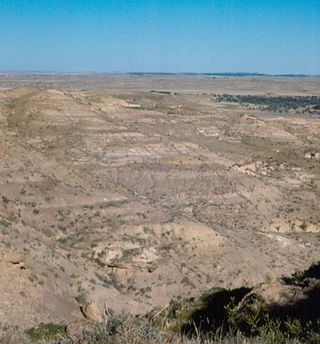
The Lance (Creek) Formation is a division of Late Cretaceous rocks in the western United States. Named after Lance Creek, Wyoming, the microvertebrate fossils and dinosaurs represent important components of the latest Mesozoic vertebrate faunas. The Lance Formation is Late Maastrichtian in age, and shares much fauna with the Hell Creek Formation of Montana and North Dakota, the Frenchman Formation of southwest Saskatchewan, and the lower part of the Scollard Formation of Alberta.
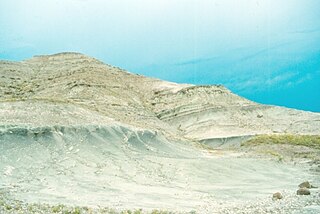
The Two Medicine Formation is a geological formation, or rock body, in northwestern Montana and southern Alberta that was deposited between 83.5 ± 0.7 Ma and 70.6 ± 3.4 Ma, during Campanian time. It crops out to the east of the Rocky Mountain Overthrust Belt, and the western portion of this formation is folded and faulted while the eastern part, which thins out into the Sweetgrass Arch, is mostly undeformed plains. Below the formation are the nearshore deposits of the Virgelle Sandstone, and above it is the marine Bearpaw Shale. Throughout the Campanian, the Two Medicine Formation was deposited between the western shoreline of the Late Cretaceous Interior Seaway and the eastward advancing margin of the Cordilleran Overthrust Belt. The Two Medicine Formation is mostly sandstone, deposited by rivers and deltas.

The Laramie Formation is a geologic formation of Late Cretaceous (Maastrichtian) age, named by Clarence King in 1876 for exposures in northeastern Colorado, in the United States. It was deposited on a coastal plain and in coastal swamps that flanked the Western Interior Seaway. It contains coal, clay and uranium deposits, as well as plant and animal fossils, including dinosaur remains.
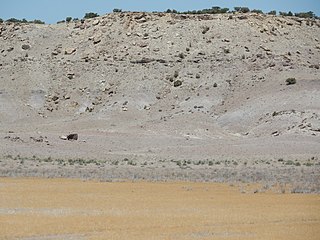
The Cedar Mountain Formation is the name given to a distinctive sedimentary geologic formation in eastern Utah, spanning most of the early and mid-Cretaceous. The formation was named for Cedar Mountain in northern Emery County, Utah, where William Lee Stokes first studied the exposures in 1944.

The Cloverly Formation is a geological formation of Early and Late Cretaceous age that is present in parts of Montana, Wyoming, Colorado and Utah in the western United States. It was named for a post office on the eastern side of the Bighorn Basin in Wyoming by N.H. Darton in 1904. The sedimentary rocks of formation were deposited in floodplain environments and contain vertebrate fossils, including a diverse assemblage of dinosaur remains. In 1973, the Cloverly Formation Site was designated as a National Natural Landmark by the National Park Service.

The Bearpaw Formation, also called the Bearpaw Shale, is a geologic formation of Late Cretaceous (Campanian) age. It outcrops in the U.S. state of Montana, as well as the Canadian provinces of Alberta and Saskatchewan, and was named for the Bear Paw Mountains in Montana. It includes a wide range of marine fossils, as well as the remains of a few dinosaurs. It is known for its fossil ammonites, some of which are mined in Alberta to produce the organic gemstone ammolite.
The Milk River Formation is a sandstone-dominated stratigraphic unit of the Western Canada Sedimentary Basin in southern Alberta, Canada. It was deposited in near-shore to coastal environments during Late Cretaceous time. Based on uranium-lead dating, palynology and stratigraphic relationships, deposition occurred between ~84.1 and 83.6 Ma.
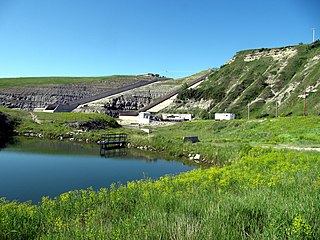
The St. Mary River Formation is a geologic formation of Late Cretaceous age of the Western Canada Sedimentary Basin in southwestern Alberta and northwesternmost Montana. It was first described from outcrops along the St. Mary River by George Mercer Dawson in 1883, and it takes its name from the river.
The Moreno Hill Formation is a geological formation in western New Mexico whose strata were deposited in the Late Cretaceous. Dinosaur remains are among the fossils that have been recovered from the formation.
The Denver Formation is a geological formation that is present within the central part of the Denver Basin that underlies the Denver, Colorado, area. It ranges in age from latest Cretaceous (Maastrichtian) to early Paleocene, and includes sediments that were deposited before, during and after the Cretaceous-Paleogene boundary event.

The Point Loma Formation is a sedimentary geological formation in Southern California. The strata date back to the Late Cretaceous epochs of the Cretaceous period, during the Mesozoic Era.

The Frontier Formation is a sedimentary geological formation whose strata date back to the Late Cretaceous. The formation's extents are: northwest Colorado, southeast Idaho, southern Montana, northern Utah, and western Wyoming. It occurs in many sedimentary basins and uplifted areas.
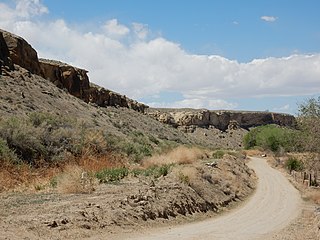
The Pictured Cliffs Formation is a Campanian geologic formation in the San Juan Basin of New Mexico. Dinosaur remains are among the fossils that have been recovered from the formation, although none have yet been referred to a specific genus.

The Point Lookout Sandstone is a Cretaceous bedrock formation occurring in New Mexico and Colorado.
The Ringbone Formation is a Campanian geologic formation in southwestern New Mexico.

The Tres Hermanos Formation is a geologic formation in central and west-central New Mexico. It contains fossils characteristic of the Turonian Age of the late Cretaceous.

The Tropic Shale is a Mesozoic geologic formation. Dinosaur remains are among the fossils that have been recovered from the formation, including Nothronychus graffami. The Tropic Shale is a stratigraphic unit of the Kaiparowits Plateau of south central Utah. The Tropic Shale was first named in 1931 after the town of Tropic where the Type section is located. The Tropic Shale outcrops in Kane and Garfield counties, with large sections of exposure found in the Grand Staircase–Escalante National Monument.
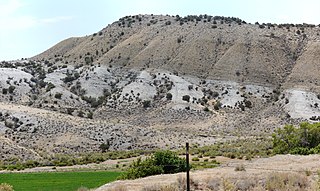
The Mowry Shale is an Early Cretaceous geologic formation. The formation was named for Mowrie Creek, northwest of Buffalo in Johnson County, Wyoming.

The Hensel Formation or Hensel Sand is a Mesozoic geologic formation in Texas. Fossil ornithopod tracks have been reported from the formation.

The Mesaverde Group is a Late Cretaceous stratigraphic group found in areas of Colorado, New Mexico, Utah, and Wyoming, in the Western United States.
















